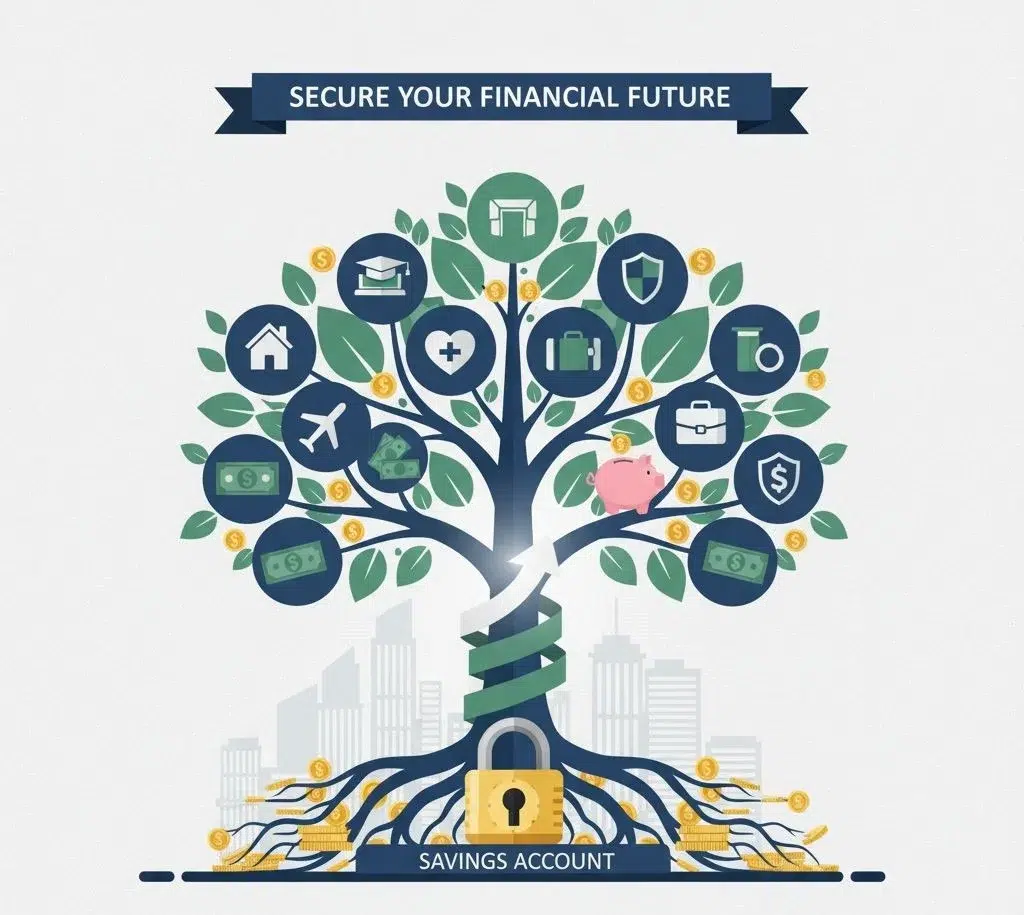How a Savings Account Can Secure Your Financial Future
Financial stability is a need, not a luxury, in an uncertain world. A savings account is one of the easiest yet most powerful tools to create stability, whether you’re saving for a home, emergency fund, or retirement.
In contrast to contemporary investment options, a savings account may appear simple, but it is essential to building a solid financial foundation. It is accessible, safe, and made to support consistent long-term financial growth. This post will discuss how a savings account can help you safeguard your financial future and how to use it wisely to reach long-term objectives.
Understanding What a Savings Account Is
An interest-bearing deposit account at a financial institution that lets you safely keep money is called a savings account. Interest savings accounts encourage you to put money aside for future needs, in contrast to checking accounts, which are mainly for daily expenses.
Important features of a savings account include:
- Safety: Your money is protected even in the event of a bank failure because your deposits are usually insured up to a certain amount (for example, by the FDIC in the United States).
- Interest earnings: Your money grows passively as you receive a tiny return on your balance.
- Liquidity: It’s perfect for short-term objectives or emergencies because you can quickly withdraw money when you need it.
- Low risk: There is less chance of losing your principal when investing in savings accounts than when buying stocks or cryptocurrency.
In summary, it’s a low-risk, secure place for anyone to start developing sound financial practices.
Creating an Emergency Fund
From unexpected job loss to auto repairs or medical emergencies, life is full of surprises. Having money saved up for these kinds of situations can make the difference between being in debt and surviving.
Your emergency fund should be in a savings account since it provides both safety and liquidity.
A minimum of three to six months’ worth of living expenses should be saved in your emergency fund, according to experts. In this manner, you can pay for unforeseen expenses without using credit cards or high-interest loans.
For instance, if your monthly expenses are $2,500, you should aim to have between $7,500 and $15,000 set aside for emergencies. That sum will remain accessible and earn interest until you need it if you keep it in a high-yield savings account.
Encouraging Consistent Saving Habits
Consistency is one of the most difficult aspects of personal finance. Saving money is easy to plan, but more difficult to carry out. Automating discipline is aided by a savings account.
The majority of banks let you:
- Establish monthly automatic transfers from checking to savings.
- Round up purchases and deposit the difference.
- Make goal-based sub-accounts, such as “Emergency Fund” or “Vacation Fund.”
Because of these features, saving becomes a natural part of your monthly routine and is simple and consistent. Without the hassle of manual budgeting, those little deposits add up to significant savings over time.
Growing Your Money Safely with Interest
Interest rates on savings accounts provide consistent, risk-free growth, even though they might not be able to match stock market returns.
Depending on the bank and economy, a lot of high-yield savings accounts in 2025 offer annual percentage yields (APYs) ranging from 4% to 5%. Compared to traditional savings accounts, which frequently pay less than 1%, that is a substantial increase.
For instance:
Keeping $10,000 in a high-yield savings account with an annual percentage yield (APY) of 4.5% will yield approximately $450 in interest over the course of a year, with no risk to your principal.
Because they offer interest, liquidity, and security, savings accounts are a crucial component of a well-rounded financial plan.
Supporting Both Short-Term and Long-Term Goals
Savings accounts are ideal for short-term financial objectives that need to be accessible and safe, like
- a down payment on a home.
- Expenses for a wedding or vacation
- The cost of tuition or ongoing education
- Fund for car replacement
Your savings account serves as the first line of defense for long-term financial security before you venture into riskier assets like real estate or mutual funds.
As you prepare for more significant, long-term wealth-building opportunities, consider your savings account to be your financial safety net.
Protecting Your Money from Market Volatility
The state of the world economy is not always predictable. Even conservative investments can lose value due to stock market fluctuations. Your money is protected from market risk by a savings account.
Your principal is unaffected during recessions, and your returns albeit small ones keep coming in. Because of their dependability, savings accounts are a vital component of financial diversification, helping to balance out the riskier assets in your investment portfolio.
A savings account gives conservative savers or retirees the assurance that their necessary funds are safe and accessible.
Improving Your Financial Profile and Credit
Savings accounts have a significant but indirect impact on your financial well-being even though they don’t directly affect your credit score. Because consistent saving practices show financial responsibility, lenders and other financial institutions tend to view savers more favorably.
You can prevent debt, make on-time bill payments, and gradually improve your credit history by maintaining a healthy savings balance. Additionally, proving that you have a savings cushion enhances your financial credibility if you ever apply for a loan or mortgage.
Teaching Financial Responsibility
Establishing a savings account for kids or teenagers is a great way for families to instill financial literacy at a young age. Children learn the importance of setting goals, saving, and earning interest—habits that can influence their financial stability for the rest of their lives.
Nowadays, a lot of banks provide youth savings accounts with low minimum balances, parental controls, and interactive online tools that let young savers see how much they’ve saved.
Leveraging Modern Savings Account Features
Savings accounts nowadays are more intelligent and practical than before. Managing your finances is now easy thanks to fintech innovation and digital banking.
Mobile apps that track deposits and interest earnings in real time.
- Examples of modern features.
- dashboards for setting goals that show the status of particular savings objectives.
- instantaneous account transfers.
- AI-powered automated savings tools that maximize contributions.
Selecting a bank with easy-to-use technology can enhance the interactive and rewarding experience of saving.
Comparing Different Types of Savings Accounts
Not all savings accounts are the same. To make the most of your money, it’s crucial to choose one that fits your goals.
| Type | Best For | Key Features |
| Traditional Savings Account | Everyday savings | Widely available, lower interest, easy access |
| High-Yield Savings Account | Earning higher interest | Online banks, better APY, digital access |
| Money Market Account | Larger balances | Check-writing privileges, competitive interest |
| Certificate of Deposit (CD) | Long-term savings | Fixed term, higher interest, early withdrawal penalty |
| Joint Savings Account | Couples or families | Shared ownership, easy fund management |
Tip: For flexibility and better returns, a high-yield savings account is often the best balance between accessibility and growth.
How to Maximize the Benefits of Your Savings Account
To get the most out of your savings account:
- Make deposits automatically: Consider saving as a fixed monthly expense.
- Benefit from high-yield choices: Examine and contrast APYs.
- Different objectives: Use distinct accounts for future purchases, travel, and emergencies.
- Preserve your savings for actual emergencies by avoiding needless withdrawals.
- Review frequently: As your income fluctuates, reevaluate your savings objectives and modify your contributions.
You can gradually accumulate wealth and maintain your financial readiness for life’s obstacles by adhering to these strategies.
The Psychological Benefits of Saving
Saving money offers emotional stability in addition to financial stability. You feel more in control of life’s uncertainties and experience less anxiety when you know you have a safety net.
This confidence that results from being ready for anything unexpected is known by psychologists as “financial peace of mind.” Financial stability can become a lifestyle rather than just a goal because even small savings can improve general well-being.
Common Mistakes to Avoid
Despite the simplicity of savings accounts, people frequently make a few preventable errors:
- All funds are kept in checking accounts, which do not yield interest.
- Ignoring more advantageous APY options
- Frequently withdrawing, which restricts growth
- Not modifying deposits when income increases
Your savings plan will continue to be successful and future-focused if you steer clear of these pitfalls.
How a Savings Account Fits into Your Financial Plan
A savings account is intended to supplement investments, not to take their place. It serves as your financial safety net, preventing your long-term objectives from being derailed by urgent needs.
A strong financial plan includes:
- Checking account for daily transactions
- Savings account for liquidity and security
- Investment accounts for growth
- Retirement accounts for long-term wealth
Together, these elements form a well-balanced financial ecosystem that supports your present as well as your future.
Final thought
Despite being one of the most basic financial instruments, a savings account’s strength is in its consistency, safety, and dependability. It serves as the cornerstone upon which financial security is constructed, from setting up an emergency fund to accomplishing life goals.
You can turn your savings into a safety net and eventually a step toward financial independence by picking the appropriate account, saving consistently, and utilizing favorable interest rates.
Thus, begin now if you haven’t already. Establish your objectives, open a savings account, and take charge of your financial future one deposit at a time.



